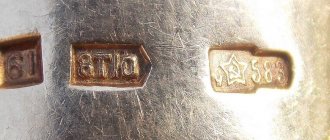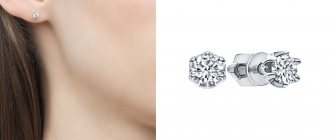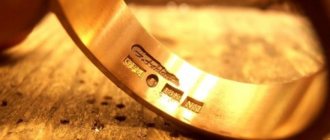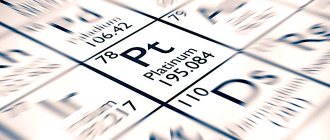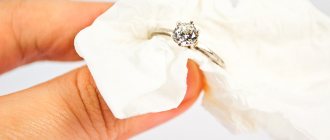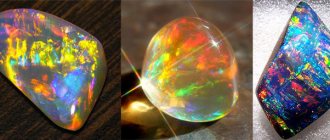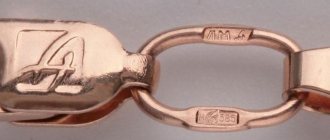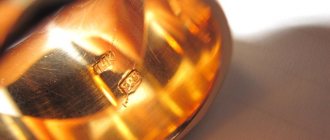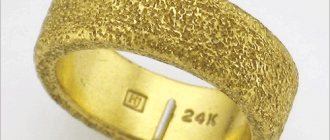Jewelry production in the USSR was subordinated to the state
After the October Revolution, with the advent of Bolshevik power, private jewelers in Russia were abolished. The jewelry industry was transformed, the workshops of imperial times were reorganized into factories. Some companies were able to withstand this shock and maintain their identity. They are still operating and have become private firms again.
We are interested in how things were in the jewelry industry of Soviet times. As with all products produced in the USSR, GOST was established for gold jewelry. This trademark was stamped on every product, and only it guaranteed the high quality of the product. This approach killed originality - all the decorations were the same, there was no originality and style.
If everything is clear with the style of jewelry, then what about the quality? There is no clear opinion on this matter. Not all Soviet jewelry factories received sufficient funding to produce exquisite goods. Therefore, mass market companies were forced to save on everything. Artificially created sapphires, emeralds and rubies were used, which significantly reduced production costs.
VIRTUAL MUSEUM
Synthetic corundum is a single crystal of aluminum oxide, painted in different colors. People often ask: “What color are artificial corundums?” So, synthetic corundum imitates almost all precious stones. Thus, the Korund enterprise in the city of Dzerzhinsk, for example, offers corundums of completely different colors, including red (ruby colors), light blue, blue and dark blue (sapphire colors), alexandrite corundums, light, dark and purple amethyst corundums . Light yellow, yellow and orange-yellow topaz corundums are also offered.
For example, in the photo below - Soviet-made pink corundum
The padparadscha (padparadshah) corundums stand apart - these are bright pinkish-orange corundums. Note that the word "padparadshah" (padparadshah), denoting the pink-orange color of corundum, is a corruption of the Sinhalese word padmaragaya (lotus color).
There is also “demburite corundum” (dark yellow). In addition, synthetic light green corundum is available.
The photo below shows red (and even more likely crimson) ruby artificial Soviet corundum (photo taken using a USB microscope with 200x magnification). Pay attention to the stripes, these are traces of cutting made by a cutting machine
This is what a ring with this dark red stone looks like.
Synthetic corundum is mainly aluminum oxide Al2O3. A melt is made, which is then crystallized (complete crystallization of an industrial melt takes about a week). At the beginning of crystallization, the crystal is colorless, but then it turns slightly pink. In order to change the color of artificial corundum, there are various methods. So, if you shine an ultraviolet lamp on pinkish corundum, you will get a wine-brownish corundum color (see example in the photo below). You can also achieve a brown color by adding iron (note that this brown color is similar to rust).
Adding some chromium ions will give you a red color (like ruby), adding manganese will give you a pink color, and vanadium will give you a green color in natural light and purple in artificial light (artificial alexandrite). The addition of nickel gives a yellow color (a la yellow topaz), and titanium gives a purple-pink color (amethyst). The blue color is obtained by adding 1.5% iron oxide and 0.5% chromium oxide
Here, for example, is synthetic Soviet amethyst corundum under a microscope.
Here it is in the product. Differences in color in photos are caused by different lighting: the top photo was taken with a USB microscope with illumination, the photo below was taken under natural light outside.
The first synthetic corundum (it was a ruby) was created in 1837. In 1847, the first synthetic blue corundum (artificial sapphire) was produced. But for the first time, a stone suitable for cutting into jewelry was obtained only in 1877. The possibility of industrial production of synthetic corundum was first discussed in 1903. Things took off: in 1907, the global annual production of synthetic rubies reached 5 million carats.
In Russia, the first industrial artificial corundum was produced in 1939. This task was mainly dealt with by the Institute of Crystallography of the Russian Academy of Sciences. A.V. Shubnikova. In 1947, an industrial method and equipment for crystallizing synthetic ruby in the form of rods was developed there. In 1950 A.V. Shubnikov and S.K. Popov was awarded the State Prize for developing methods for growing corundum crystals and organizing their industrial production. In general, in the USSR the following equipment was used for growing crystals: KPC, Diakont, Sapphire-2U, Sapphire-3, Granat-3 and Sapphire-2MG.
There is an opinion that synthetic corundum became very popular in jewelry in the USSR in the 70-80s. But this happened earlier. Thus, Chernorechensky already in the 50s of the 20th century obtained the first crystals of dark red ruby and developed technologies for the production of alexandrites, sapphires, amethysts and topazes for the jewelry industry.
As for the question “is it possible to distinguish synthetic rubies and sapphires from real ones”, it is not difficult to answer. In the USSR, the vast majority of rubies, sapphires, tourmalines and other large transparent cut stones were synthetic. There is especially little chance of a natural stone when it comes to silver. In the USSR, synthetic corundum was neither rare nor expensive: the cost of one stone, including cutting, was about 3 rubles 20 kopecks.
And yet, there are methods that allow you to distinguish artificial corundum from real gemstones with 100% confidence. Thus, natural and artificial crystals have different absorption spectra. For such studies, a gemological spectrometer is used.
There is another method: the so-called immersion method. The crystal to be examined is placed in a special liquid that makes it completely transparent. This liquid is different for different minerals. Now the stone can be examined by studying its internal structure under a microscope, and especially carefully the inclusions. Thus, in natural rubies of Burma, crystals of spinel and apatite are found, and in rubies of Sri Lanka - zircon, garnets, pyrite... Also, Burmese rubies are characterized by an uneven distribution of color. Natural sapphires also have their own peculiarities: there is an abundance of gas-liquid inclusions that form patterns reminiscent of honeycombs, grids and fingerprints. Synthetic corundums are distinguished by gas inclusions that are round, oval, elongated or spindle-shaped), single and forming clusters. Solid inclusions in synthetic corundum can be represented by “non-melting”.
Even a regular microscope is suitable for searching for inclusions (or lack thereof). The photo below shows inclusions in natural amethyst under a microscope.
Also, some synthetic stones glow differently in ultraviolet rays than natural ones (for example, alexandrite-like synthetic corundum).
Natural corundums
The color of natural corundums is also due to impurities that replace aluminum. The admixture of chromium gives the ruby a violet-red color; the brightness of the color depends on the amount of chromium: in bright red crystals there is 2-4%, in pale pink crystals - tenths of a percent. The admixture of titanium gives a blue color (sapphire), iron - yellow (padparadscha), iron and manganese - brown and pink. Sometimes zonally colored crystals of natural corundum are found, where alternating stripes are observed. For example, lilac and violet. Completely colorless corundum crystals have not yet been found in nature.
The name of the mineral comes from the Sanskrit word Kuruwinda - ruby. In the Middle Ages, pink ruby was called a carbuncle. Until the 19th century, all blue gems were called sapphires, and later only blue corundums were called. In Rus', ruby and sapphire were called yakhonts - “scarlet yakhont” and “azure yakhont”. Sapphires are characterized by asterism: a bright star with three, six or twelve rays is clearly visible on a polished stone. The variety with a blurry image is called girosol. This optical effect is associated with rutile inclusions. Rubies with sterism are much less common. Corundums with asterism are usually cut into cabochons.
In the Urals there are dark red ruby crystals measuring 0.5-1 cm, sometimes up to 8 cm. The smallest ruby crystals end with a shiny facet. These crystals are highly fractured. Finds of ruby in the USSR were noted in the South-Western Pamirs and Kazakhstan. Sapphires were found in the Baikal region and the Urals.
Literature: Samsonov Ya.P., Turinge A.P. “Gems of the USSR”, Moscow, Nedra, 1985
In Soviet jewelry, artificial stones were mainly used
Synthetic stones were actively used in the Soviet jewelry industry, and there is no escape from this. For the inhabitants of that era, rings, earrings and necklaces with stone inserts were a real luxury. It didn’t matter that the stones were not real, citizens were ready to pay any money to show off such decorations. Now the “treasures” of those times are selling for the price of the metal.
In the 80s of the last century, scientists in the USSR managed to make a scientific breakthrough - to create an artificial diamond. Cubic zirconia began to cost unimaginable money. People were not embarrassed by the fact that the stone was synthetic. For them it was a diamond, and its origin did not matter. Interestingly, the inventors of cubic zirconia were given a modest reward of 100 rubles each. The jewelry market of the Soviet Union received millions of cash flows thanks to this invention, so the authorities could have been more generous.
How a synthetic ruby is born
The Verneuil method allows you to grow crystals in much the same way as stalagmites grow in a cave. Finely ground aluminum powder, or charge, is poured in a thin stream into a special furnace, where it enters the flame of detonating gas. The flame is heated to very high temperatures - more than 2000 degrees, so the powder melts. Drops of the melt flow down onto the stand with the seed and crystallize, forming a corundum boule.
The Czochralski method is used when high-quality gem quality rubies are needed. The crystals are more uniform, with fewer gas bubbles and inclusions, and a low level of residual stress. At the same time, the Czochralski method is more expensive: its use requires expensive equipment, as well as crucibles made of refractory metals - for example, platinum.
When synthesizing rubies using the Czochralski method, the initial mixture of oxides is placed in a crucible and heated with a spiral heater. A seed rotating at a speed of 5-30 mm/hour is brought to the surface of the melt. It gradually rises, “pulling” the crystal upward. As a result, a ruby is formed with a length of 200-250 mm and a diameter of up to 20-30 cm.
RusGems ruby grown using the Czochralski method
There was plenty of real trophy jewelry on the consignment market
Despite the massiveness and monotony of the Soviet jewelry industry, real nuggets could be found at that time. Of course, they were not sold in official stores. We were talking about consignment jewelry, among which were family jewelry from pre-revolutionary times, post-war trophies, and confiscated items from political prisoners. After the Great Patriotic War, a lot of jewelry from Eastern Europe appeared on the territory of the USSR, imported as war trophies.
Still, the majority of the population could not afford the purchase of these delights, and they were content with traditional factory products. Very often, gold jewelry and jewelry were passed down from generation to generation. A woman received “grandmother’s gold” when she got married.
Properties of synthetic ruby
Synthetic ruby is not inferior in physical and optical properties to natural ruby. It has a hardness of 9 on the Mohs scale, making it one of the hardest minerals. In terms of hardness, ruby is second only to diamond and moissanite.
Synthesis technologies make it possible to reproduce the optical properties characteristic of natural stones. Thus, the Verneuil method can be used to obtain star rubies - stones with the effect of asterism. To do this, a small amount of titanium oxide is introduced into the charge, and the resulting crystals are annealed. Thin needles of rutile are formed inside the ruby, which can be located in different ways. If they are arranged in concentric rings, they look like a multi-rayed star; if they are oriented only in one direction, they resemble a cat's eye.
Earrings
In the USSR, women, if possible, bought gold earrings. The design was different - both quite modest and spectacular. The type of clasp too.
English ones were more valued because it was believed that earrings with a long hook were unsightly.
The most common models:
Ball earrings. They were relatively cheap, but looked flashy due to their “puffiness”.
Earrings-"kalachi". Also “inflated”. For Soviet women this is a constant favorite.
“Samovar” earrings. They look quite nice.
And such rather modest jewelry, in my opinion, could be worn by a modern girl.
The most prestigious Soviet earrings are “raspberry”. Sapphires, of course, are artificial.
Gold drop earrings with amber.
And this is most likely a handicraft product. Although officially there were no private jewelers in the USSR. Silver earrings with chrysoprase look unusual and original.
Soft agate
Pink agate is considered to be relatively inexpensive, but often found in nature. This mineral is formed with the help of magnesium oxide, which affects the color and structure of the gem. Agate has very unusual patterns that cannot be found in other minerals. It is softly processed, so jewelers use it very widely. Jewelry made from pink agate is inexpensive, because it is a semi-precious stone. You can see it in the photo above.
Craftsmen love agate. Many beautiful jewelry are made from it. It is suitable for making bracelets, pendants, earrings. Sometimes rings are even cut from solid pieces of agate. Many products contain cabochon stones.
